
| Version | Summary | Created by | Modification | Content Size | Created at | Operation |
|---|---|---|---|---|---|---|
| 1 | Dasha Mihaylova | + 2370 word(s) | 2370 | 2022-01-11 03:16:07 | | | |
| 2 | Vivi Li | Meta information modification | 2370 | 2022-02-10 08:57:50 | | | | |
| 3 | Vivi Li | Meta information modification | 2370 | 2022-02-10 11:50:50 | | |
Video Upload Options
The volatile compounds of eight peach varieties (Prunus persica L.)—“Filina”, “Gergana”, “Ufo-4”, “July lady”, “Laskava”, “Flat Queen”, “Evmolpiya”, and “Morsiani 90”—growing in Bulgaria were analyzed for the first time. Gas chromatography–mass spectrometry (GC–MS) analysis and the HS-SPME technique revealed the presence of 65 volatile compounds; the main identified components were aldehydes, esters, and fatty acids. According to the provided principal component analysis (PCA) and hierarchical cluster analysis (HCA), the relative quantities of the identified volatile compounds depended on the studied peach variety. The results obtained could be successfully applied for the metabolic chemotaxonomy of peaches.
1. Introduction
2. Gas Chromatography–Mass Spectrometry (GC–MS) Profiling of Volatile Compounds of Analyzed Peach Samples
 Figure 1. TIC chromatogram obtained for peach and nectarine samples.
Figure 1. TIC chromatogram obtained for peach and nectarine samples.
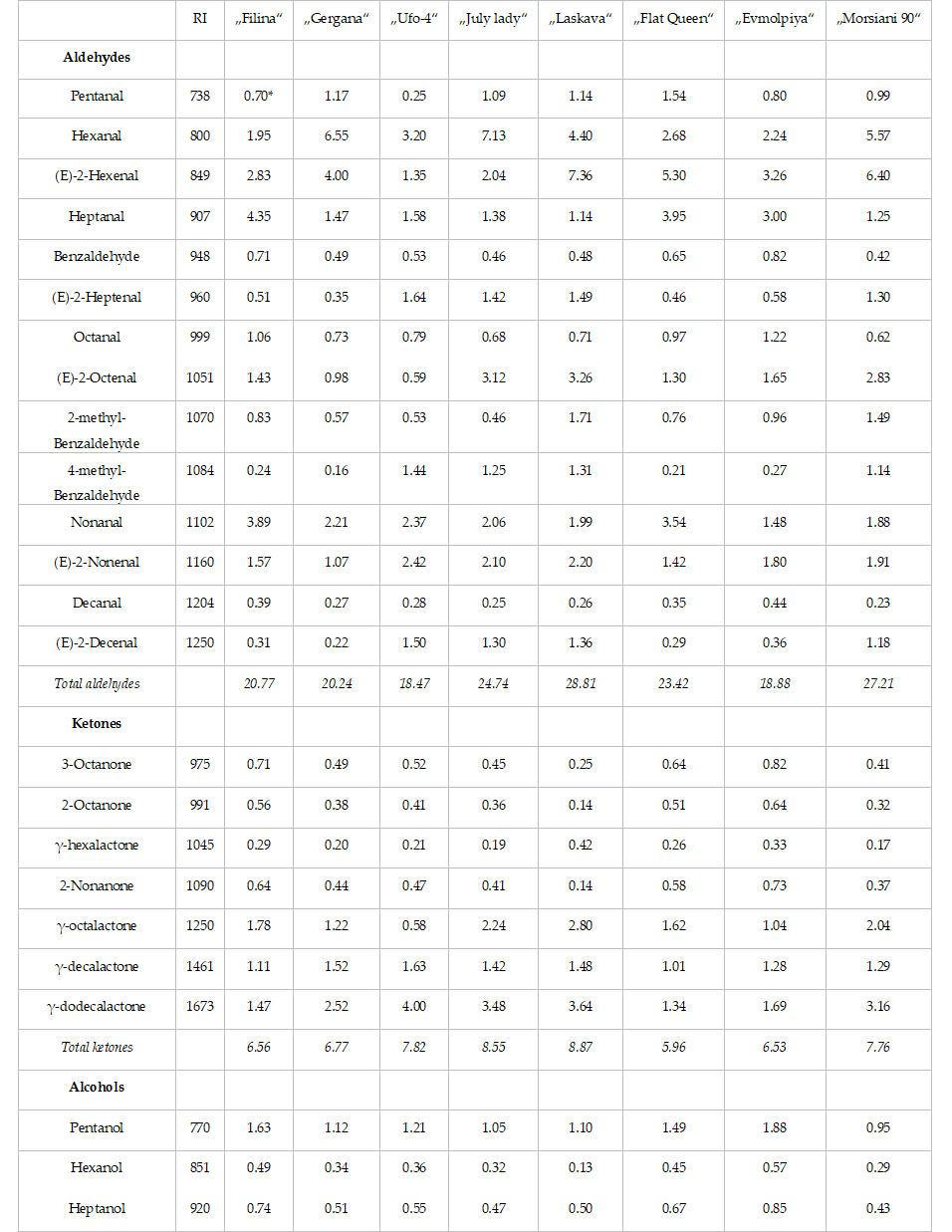 Table 1. Identified volatile compounds in peach varieties analyzed by GC–MS. The results are given as % of Total Ion Current *.
Table 1. Identified volatile compounds in peach varieties analyzed by GC–MS. The results are given as % of Total Ion Current *.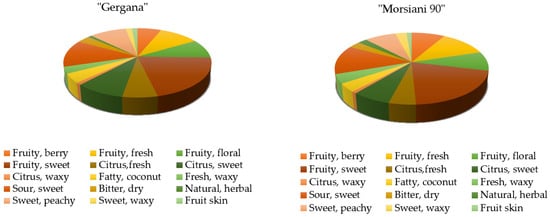
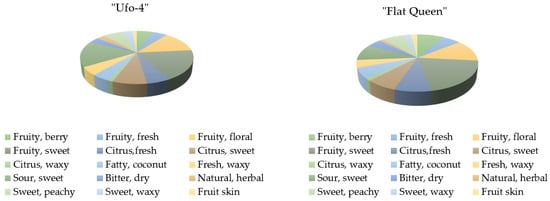
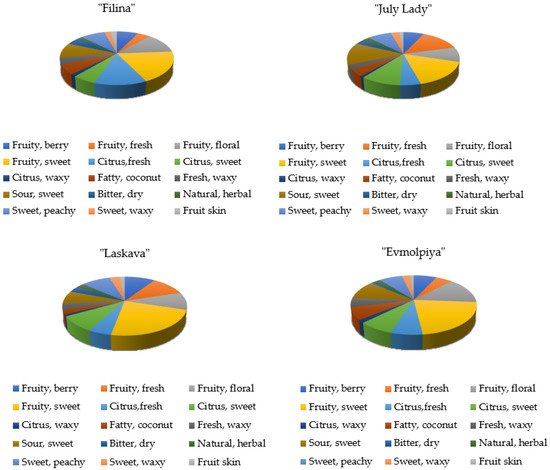
3. Principal Component Analysis (PCA) and Hierarchical Cluster Analysis (HCA) of GC–MS Data
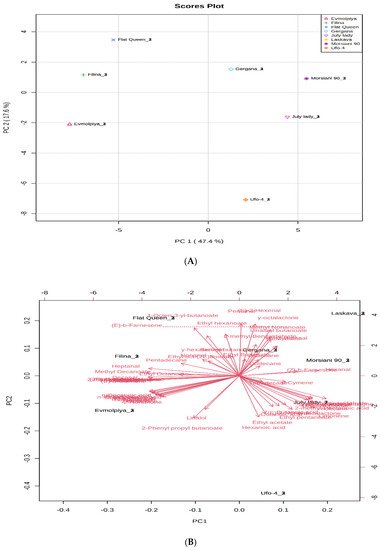
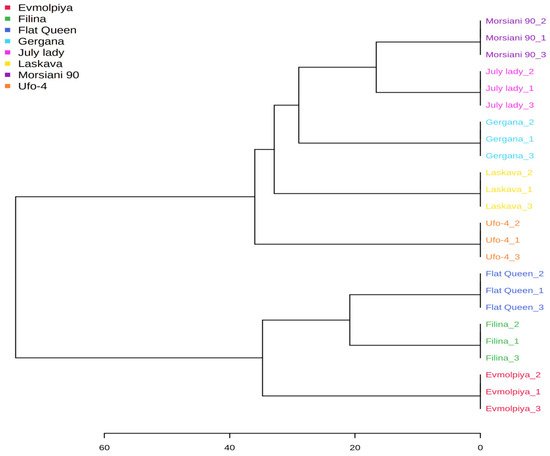
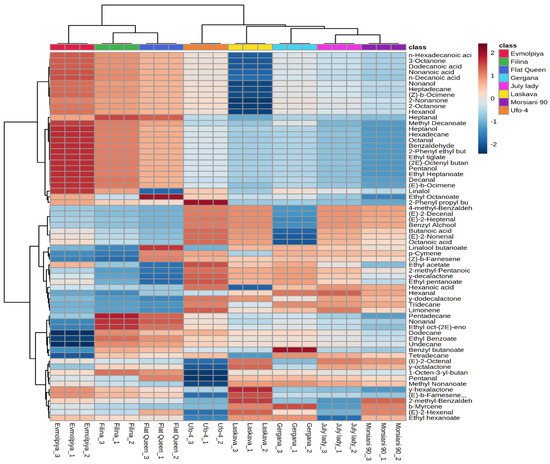
References
- Bassi, D.; Mignani, I.; Spinardi, A.; Tura, D. Chapter 23—PEACH (Prunus persica (L.) Batsch). In Nutritional Composition of Fruit Cultivars; Simmonds, M.S.J., Preedy, V.R., Eds.; Academic Press: San Diego, CA, USA, 2016; pp. 535–571. ISBN 978-0-12-408117-8.
- Font i Forcada, C.; Gradziel, T.M.; Gogorcena, Y.; Moreno, M.Á. Phenotypic diversity among local Spanish and foreign peach and nectarine accessions. Euphytica 2014, 197, 261–277.
- Davidović, S.M.; Veljović, M.S.; Pantelić, M.M.; Baošić, R.M.; Natić, M.M.; Dabić, D.Č.; Pecić, S.P.; Vukosavljević, P.V. Physicochemical, Antioxidant and Sensory Properties of Peach Wine Made from Redhaven Cultivar. J. Agric. Food Chem. 2013, 61, 1357–1363.
- Liu, H.; Cao, J.; Jiang, W. Evaluation of physiochemical and antioxidant activity changes during fruit on-tree ripening for the potential values of unripe peaches. Sci. Hortic. 2015, 193, 32–39.
- Cantín, C.M.; Moreno, M.A.; Gogorcena, Y. Evaluation of the Antioxidant Capacity, Phenolic Compounds, and Vitamin C Content of Different Peach and Nectarine Breeding Progenies. J. Agric. Food Chem. 2009, 57, 4586–4592.
- Campbell, O.; Padilla-Zakour, O. Phenolic and carotenoid composition of canned peaches (Prunus persica) and apricots (Prunus armeniaca) as affected by variety and peeling. Food Res. Int. 2013, 54, 448–455.
- Liu, H.; Cao, J.; Jiang, W. Evaluation and comparison of vitamin C, phenolic compounds, antioxidant properties and metal chelating activity of pulp and peel from selected peach cultivars. LWT Food Sci. Technol. 2015, 63, 1042–1048.
- Eduardo, I.; Chietera, G.; Bassi, D.; Rossini, L.; Vecchietti, A. Identification of key odor volatile compounds in the essential oil of nine peach accessions. J. Sci. Food Agric. 2010, 90, 1146–1154.
- Muto, A.; Müller, C.; Bruno, L.; McGregor, L.; Ferrante, A.; Ada, A.; Chiappetta, C.; Bitonti, M.; Rogers, H.; Spadafora, N. Fruit volatilome profiling through GC × GC-ToF-MS and gene expression analyses reveal differences amongst peach cultivars in their response to cold storage. Sci. Rep. 2020, 10, 1–16.
- Schwab, W.; Davidovich-Rikanati, R.; Lewinsohn, E. Biosynthesis of plant-derived flavor compounds. Plant J. 2008, 54, 712–732.
- Ortiz Catalan, A.; Echeverría, G.; Graell, J.; López, M.L.; Lara, I. Biosynthesis of volatile compounds during on-tree maturation of “Rich Lady” peaches. Acta Hortic. 2012, 962, 515–522.
- Sánchez, G.; Venegas-Calerón, M.; Salas, J.; Monforte, A.; Badenes, M.; Granell, A. An integrative “omics” approach identifies new candidate genes to impact aroma volatiles in peach fruit. BMC Genom. 2013, 14, 343.
- Romero, I.; García-González, D.L.; Aparicio-Ruiz, R.; Morales, M.T. Study of Volatile Compounds of Virgin Olive Oils with “Frostbitten Olives” Sensory Defect. J. Agric. Food Chem. 2017, 65, 4314–4320.
- Gur, E.; Ekinci, N.; Gundogdu, M.A.; Seker, M. Comparison of Fruit Aromatic Compounds of Cardinal Peach, Armking and White Nectarine Varieties. In Proceedings of the International INES Academic Researches Congress, Antalya, Turkey, 18–21 October 2017; pp. 2200–2207.
- Engel, K.H.; Tressl, R. Studies on the volatile components of two mango varieties. J. Agric. Food Chem. 1983, 31, 796–801.
- Krishna Kumar, S.; Hern, T.; Liscombe, D.; Paliyath, G.; Sullivan, J.A.; Subramanian, J. Changes in the volatile profile of ‘Fantasia’ nectarines treated with an enhanced freshness formulation (EFF) containing hexanal. Hortic. Environ. Biotechnol. 2020, 61, 525–536.
- Maul, F.; Sargent, S.A.; Sims, C.A.; Baldwin, E.A.; Balaban, M.O.; Huber, D.J. Tomato Flavor and Aroma Quality as Affected by Storage Temperature. J. Food Sci. 2000, 65, 1228–1237.
- An, K.; Liu, H.; Fu, M.; Qian, M.C.; Yu, Y.; Wu, J.; Xiao, G.; Xu, Y. Identification of the cooked off-flavor in heat-sterilized lychee (Litchi chinensis Sonn.) juice by means of molecular sensory science. Food Chem. 2019, 301, 125282.
- Xi, W.; Zheng, Q.; Lu, J.; Quan, J. Comparative Analysis of Three Types of Peaches: Identification of the Key Individual Characteristic Flavor Compounds by Integrating Consumers’ Acceptability with Flavor Quality. Hortic. Plant J. 2017, 3, 1–12.
- Bento, C.; Gonçalves, A.C.; Silva, B.; Silva, L.R. Peach (Prunus Persica): Phytochemicals and Health Benefits. Food Rev. Int. 2020, 1–32.
- Arctander, S. Perfume and Flavor Chemicals (Aroma Chemicals); Montclair Publishing: Montclair, NJ, USA, 1969.
- Wang, Y.; Yang, C.; Li, S.; Yang, L.; Wang, Y.; Zhao, J.; Jiang, Q. Volatile characteristics of 50 peaches and nectarines evaluated by HP–SPME with GC–MS. Food Chem. 2009, 116, 356–364.
- Font i Forcada, C.; Guajardo, V.; Chin-Wo, S.R.; Moreno, M.Á. Association Mapping Analysis for Fruit Quality Traits in Prunus persica Using SNP Markers. Front. Plant Sci. 2019, 9, 2005.
- Bianchi, T.; Weesepoel, Y.; Koot, A.; Iglesias, I.; Eduardo, I.; Gratacós-Cubarsí, M.; Guerrero, L.; Hortós, M.; van Ruth, S. Investigation of the aroma of commercial peach (Prunus persica L. Batsch) types by Proton Transfer Reaction–Mass Spectrometry (PTR-MS) and sensory analysis. Food Res. Int. 2017, 99, 133–146.
- Aubert, C.; Milhet, C. Distribution of the volatile compounds in the different parts of a white-fleshed peach (Prunus persica L. Batsch). Food Chem. 2007, 102, 375–384.
- El Hadi, M.A.; Zhang, F.-J.; Wu, F.-F.; Zhou, C.-H.; Tao, J. Advances in Fruit Aroma Volatile Research. Molecules 2013, 18, 8200–8229.
- Duan, Y.; Dong, X.; Liu, B.; Li, P. Relationship of changes in the fatty acid compositions and fruit softening in peach (Prunus persica L. Batsch). Acta Physiol. Plant. 2013, 35, 707–713.
- Sánchez-Moreno, C.; Pascual-Teresa, S.D.; Ancos, B.D.; Cano, M.P. Nutritional Values of Fruits. In Handbook of Fruits and Fruit Processing; John Wiley & Sons: Hoboken, NJ, USA, 2006; pp. 29–44.
- Gonçalves, B.; Oliveira, I.; Bacelar, E.; Morais, M.C.; Aires, A.; Cosme, F.; Ventura-Cardoso, J.; Anjos, R.; Pinto, T. Aromas and Flavours of Fruits. In Generation of Aromas and Flavours; InTech Open: Rijeka, Croatia, 2018.
- Meng, J.; Fang, Y.; Gao, J.; Zhang, A.; Liu, J.; Guo, Z.; Zhang, Z.; Li, H. Changes in aromatic compounds of cabernet sauvignon wines during ageing in stainless steel tanks. Afr. J. Biotechnol. 2011, 10, 11640–11647.
- Mo, E.K.; Sung, C.K. Phenylethyl alcohol (PEA) application slows fungal growth and maintains aroma in strawberry. Postharvest Biol. Technol. 2007, 45, 234–239.
- Seker, M.; Gündoğdu, M.; Ekinci, N.; Gür, E. Recent Developments on Aroma Biochemistry in Fresh Fruits. Int. J. Innov. Approaches Sci. Res. 2021, 5, 84–103.
- Li, Y.; Qi, H.; Jin, Y.; Tian, X.; Sui, L.; Qiu, Y. Role of Ethylene in the Biosynthetic Pathway of Related-aroma Volatiles Derived from Fatty Acids in Oriental Sweet Melon. J. Am. Soc. Hortic. Sci. 2016, 141, 327–338.
- Jennings, W.G.; Tressl, R. Production of volatile compounds in the ripening of ‘Bartlett’ pear. Chem. Mikrobiol. Technol. Leb. 1974, 3, 52–55.
- Șeker, M.; Kaçan, A.; Gür, E.; Ekİncİ, N.; Gündoğdu, M.A. Investigation of aromatic compounds of peach and nectarine varieties grown in Canakkale ecological conditions. TABAD Tarım Bilim. Araștırma Derg. 2013, 6, 62–67.
- Wang, Y.; Yang, C.; Liu, C.; Xu, M.; Li, S.; Yang, L.; Wang, Y. Effects of Bagging on Volatiles and Polyphenols in “Wanmi” Peaches during Endocarp Hardening and Final Fruit Rapid Growth Stages. J. Food Sci. 2010, 75, S455–S460.
- Espino-Díaz, M.; Sepúlveda, D.R.; González-Aguilar, G.; Olivas, G.I. Biochemistry of Apple Aroma: A Review. Food Technol. Biotechnol. 2016, 54, 375–397.
- Lu, P.F.; Qiao, H.L.; Xu, Z.C.; Cheng, J.; Zong, S.X.; Luo, Y.Q. Comparative analysis of peach and pear fruit volatiles attractive to the oriental fruit moth, Cydia molesta. J. Plant Interact. 2013, 9, 388–395.
- Yahia, E.M. Postharvest physiology and biochemistry of fruits and vegetables. Postharvest Physiol. Biochem. Fruits Veg. 2018, 1–476.
- Rizzolo, A.; Bianchi, G.; Vanoli, M.; Lurie, S.; Spinelli, L.; Torricelli, A. Electronic nose to detect volatile compound profile and quality changes in “spring Belle” peach (Prunus persica L.) during cold storage in relation to fruit optical properties measured by time-resolved reflectance spectroscopy. J. Agric. Food Chem. 2013, 61, 1671–1685.
- Gündoğdu, M.A.; Ekinci, N.; Kaleci, N.; Şeker, M. Determination of Aromatic Compounds of Some Promising Pomegranate Genotypes. Ecol. Life Sci. 2018, 13, 142–150.
- Engel, K.H.; Flath, R.A.; Buttery, R.G.; Mon, T.R.; Teranishi, R.; Ramming, D.W. Investigation of volatile constituents in nectarines. 1. Analytical and sensory characterization of aroma components in some nectarine cultivars. J. Agric. Food Chem. 2002, 36, 549–553.
- Feng, S.; Huang, M.; Crane, J.H.; Wang, Y. Characterization of key aroma-active compounds in lychee (Litchi chinensis Sonn.). J. Food Drug Anal. 2018, 26, 497–503.
- González-Agüero, M.; Troncoso, S.; Gudenschwager, O.; Campos-Vargas, R.; Moya-León, M.A.; Defilippi, B.G. Differential expression levels of aroma-related genes during ripening of apricot (Prunus armeniaca L.). Plant Physiol. Biochem. 2009, 47, 435–440.
- Ortiz, A.; Graell, J.; López, M.L.; Echeverría, G.; Lara, I. Volatile ester-synthesising capacity in ‘Tardibelle’ peach fruit in response to controlled atmosphere and 1-MCP treatment. Food Chem. 2010, 123, 698–704.
- Goff, S.A.; Klee, H.J. Plant volatile compounds: Sensory cues for health and nutritional value? Science 2006, 311, 815–819.
- The Good Scents Company Information System. Available online: http://www.thegoodscentscompany.com/ (accessed on 21 December 2021).
- Mundfrom, D.J.; Shaw, D.G.; Ke, T.L. Minimum Sample Size Recommendations for Conducting Factor Analyses. Int. J. Test. 2005, 5, 159–168.
- Mihaylova, D.; Desseva, I.; Popova, A.; Dincheva, I.; Vrancheva, R.; Lante, A.; Krastanov, A. GC-MS Metabolic Profile and α-Glucosidase-, α-Amylase-, Lipase-, and Acetylcholinesterase-Inhibitory Activities of Eight Peach Varieties. Molecules 2021, 26, 4183.
- Bavcon-Kralj, M.; Jug, T.; Komel, E.; Fajt, N.; Jarni, K.; Živković, J.; Mujić, I. Aromatic compound in different peach cultivars and effect of preservatives on the final aroma of cooked fruits. Hem. Ind. 2014, 68, 767–779.
- Amine, E.K.; Baba, N.H.; Belhadj, M.; Deurenberg-Yap, M.; Djazayery, A.; Forrestre, T.; Galuska, D.A.; Herman, S.; James, W.P.T.; M’Buyamba Kabangu, J.R.; et al. Diet, nutrition and the prevention of chronic diseases. Am. J. Clin. Nutr. 2003, 60, 644–645.
- Montero-Prado, P.; Bentayeb, K.; Nerín, C. Pattern recognition of peach cultivars (Prunus persica L.) from their volatile components. Food Chem. 2013, 138, 724–731.




